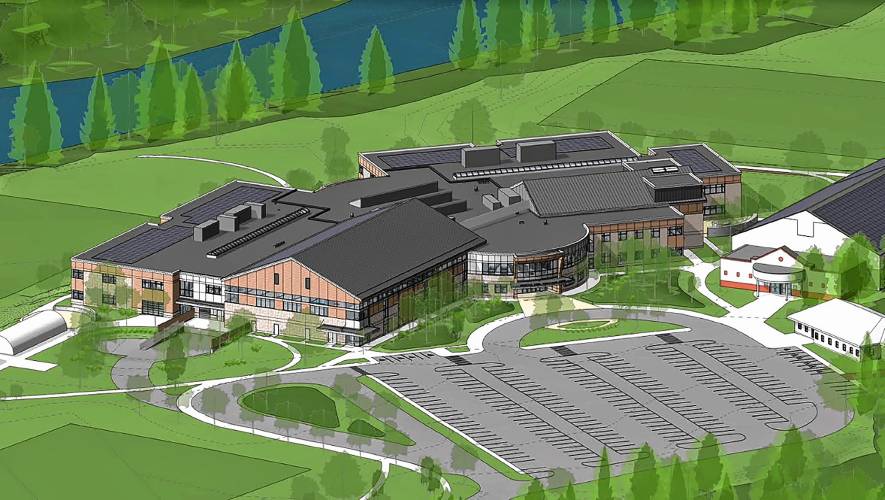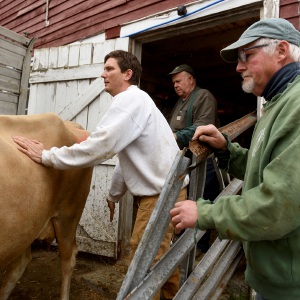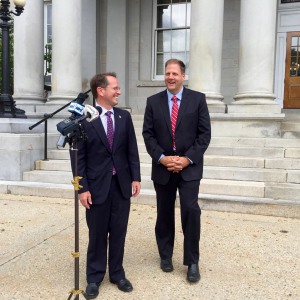School Board seeks to reassure voters as cost of proposed Woodstock high school rises

An artist's rendering of the proposed Woodstock middle and high school building, located on what it currently the school football field. (Courtesy Mountain Views Supervisory Union) Courtesy Mountain Views Supervisory Union
|
Published: 01-09-2024 12:17 PM
Modified: 01-11-2024 4:51 PM |
WOODSTOCK — The new school building project for Woodstock’s middle and high school now has a price tag of $99 million, according to an announcement last month by the Mountain Views Supervisory Union.
That number is a significant increase from the $80 million estimate projected in the fall.
At a Dec. 19 Woodstock Selectboard meeting, Ben Ford, a Woodstock representative to the supervisory union board and the new building committee’s chairman, fielded questions from residents concerned about the rising project cost and its potential tax implications.
Acknowledging that $99 million is a “significant escalation” from earlier estimates, he explained that the increase is the result of inflation and steep labor costs.
“I know everyone’s hair is going to blow back when I say this number,” Ford said as he announced the new figure, which emerged from a “costing exercise” carried out in early December. He noted that if the Mountain Views Supervisory Union (MVSU) did not take any actions to mitigate the tax rate impact, homestead tax rate increases would reach nearly 34%.
“That’s not affordable for our district,” he said. MVSU includes the member towns of Woodstock, Barnard, Bridgewater, Pomfret, Reading, Killington and Plymouth.
The proposed new building would be a two-story, 161,000-square-foot space with net-zero energy capability and capacity for 700 students. It would be fully Americans with Disabilities Act-compliant and include outdoor classrooms and community and performance spaces.
There was skepticism toward the project among Woodstock residents at the Dec. 19 meeting, particularly of a strategy the board is pursuing to reduce the tax impact by boosting enrollment. Woodstock resident Steven Thomas thanked the board for its work but expressed concern about what he saw as a lack of certainty in the discussion.
Article continues after...
Yesterday's Most Read Articles
 Herd departs Hartford’s last remaining dairy farm
Herd departs Hartford’s last remaining dairy farm
 Kenyon: What makes Dartmouth different?
Kenyon: What makes Dartmouth different?
 At Dartmouth, hundreds protest ongoing war in Gaza and express support for academic freedom
At Dartmouth, hundreds protest ongoing war in Gaza and express support for academic freedom
 Editorial: Parker parole a reminder of how violence reshapes our lives
Editorial: Parker parole a reminder of how violence reshapes our lives
 A Life: Richard Fabrizio ‘was not getting rich but was doing something that made him happy’
A Life: Richard Fabrizio ‘was not getting rich but was doing something that made him happy’
“I hear a lot of ‘ifs,’ ” he said. “So I fear the potential tax bomb of not being able to raise the enrollment of the school, and I remain unconvinced.”
Others voiced concerns about the limited water supply stifling housing growth and second homeowners pushing out families with school-aged children.
Woodstock resident Cynthia Stevens wanted to know what “Plan B” was if the bond doesn’t pass on Town Meeting Day in March.
“As long as I stay on the School Board, I’ll try again,” said Ford.
In response to questions about the possibility of renovating the current school or scaling back the scope of the project, the MVSU board has been using a “Cadillac vs. Subaru” analogy, noting that the December costing exercise resulted in some changes to the project in order to reduce its cost and that the $569 price per square foot falls within the average of recent school construction projects statewide.
Woodstock’s high school building was constructed in 1956, with the middle school added in 1968. The two-building complex serves 440 students. A facility conditions assessment completed by the Vermont Agency of Education in May 2003 found that the buildings were in poor condition. In 2021, six classrooms were rendered unusable due to a failing heating system, and the district spent $1.2 million in emergency funds to repair the heating system.
With a keen awareness that school bonds have been rejected recently by Vermont voters in a number of districts, including Waterbury, Stowe, Slate Valley and South Burlington, the MVSU board is promising that the building project will not increase property taxes by more than 16%.
“That’s a 50-50 proposition,” Ford said at the Dec. 19 Selectboard meeting. “You come up with half, and the School Board will figure out the other half.”
The 16% tax rate guarantee is essentially enforceable through the annual school budget vote, according to Ford.
“You as the taxpayers have control. You can hold us accountable for the commitments that we made; it’s not just talk,” he said over the phone, adding that school budget cuts would be a last resort.
In November 2022, Burlington voters approved a $165 million bond for a new high school, with 76% voting in favor of the initiative. The MVSU board sees the Burlington project, which will raise the city’s education tax rate by 16%, as a benchmark for a successful bond initiative and an indication of the level of tax burden that voters would be likely to support.
Because Burlington has more students than Woodstock, its per-pupil spending is lower, which in turn lessens the tax impact of the building project. But the MVSU board has expressed confidence that by pursuing a multifaceted strategy, it will be able to replicate the success of the Burlington bond vote.
To that end, the supervisory union is deploying an array of strategies to mitigate the Woodstock project’s tax impact, including private fundraising, weighing different bond types and repayment structures and working to increase enrollment numbers.
“If you don’t do things to offset that tax rate,” Ford said at the Selectboard meeting, the result is “taxpayers who can’t get behind these very important community initiatives.”
Taking a cue from independent schools, which typically maintain robust development teams, the MVSU in 2022 hired Marlena McNamee to serve as a part-time fundraising manager, a position funded by the Woodstock Economic Development Corporation. So far, $3.5 million has been raised through private donations, with a goal of $5 million raised by the first year of the project. If voters approve the bond in March, construction would begin in early 2025, with the new building scheduled to open in August 2026.
The board is exploring different options for borrowing and is considering an extended payment period. While extending the life of the loan would increase the overall cost of the project, it would keep tax rates down.
Ford is bullish on the district’s enrollment potential. In a recent phone interview, he acknowledged that there are those who would argue that “if you build it, they will come” is an unreliable strategy. But, he added, “If you don’t build it, they will leave.”
He noted that Woodstock Union Middle and High School (WUMHS) has lost 220 students over the past 20 years, but he sees cause for optimism in recent enrollment growth at the elementary school levels.
Although he did not provide specific enrollment numbers, Ford said that student numbers have trended upward in the past two to three years at the elementary levels. “We’re seeing bigger classes at the lower end,” he said over the phone, “bigger than they’ve been in a long, long time.”
The MVSU board has eyes on a 1,500-unit housing development in Killington that might net some full-time residents amid a majority of units that will be second homes. And Killington Resort plans to build 300 units of workforce housing, which may yield some students.
“We’ve lost kids,” said Ford. “And if we can turn that around and replenish what we used to have, then we can more than pay for the building and then keep driving tax rates down.”
But Woodstock resident Carol Wood expressed doubt about predictions of an increase in enrollment.
“The number of students is not going to increase,” she said. “There’s no place to live now. They can build 500 units in Killington, but that’s not necessarily going to be residences with kids.”
Ford noted that recent changes in pupil weighting under Act 127 work significantly in Woodstock’s favor. Act 127 is a law passed in 2022 intended to make education funding more equitable. It significantly alters the system of “pupil weighting” that determines how much money a district receives from the state. The more heavily weighted a district is, the more it can raise money without affecting the local tax rate. Act 127 will go into effect for the 2024-25 school year.
“We went from having 925 equalized pupils last year to 1,525 this year,” he said. “And that’s massive.” He said that he is “cautiously optimistic” that the Act 127 adjustments will result in some funding that the district hadn’t originally accounted for.
Ford expressed optimism over the phone about economic trends that seem to show inflation mitigating and loosening of the labor shortage. “And the great thing about our project,” he said, is that “the bond payments wouldn’t come online until the summer of 2027.” Additionally, there is about $5 million of contingency built into the $99 million project cost.
The bond will appear on the ballot at Town Meeting Day in March, and its passage would require a simple majority of the combined votes from the MVSU’s seven member towns. The supervisory union is scheduled to hold information sessions in each of the district’s member towns in January and February.
Representatives of the Mountain Views Supervisory Union plan to attend the Jan. 17 Pomfret Selectboard meeting at 7 p.m., for a presentation and question-and-answer session about education taxes and the upcoming school bond. The meeting will be held in person at the Pomfret town office, 5218 Pomfret Road, and remotely. The Zoom link is available at pomfretvt.us.
Dates and locations of additional public presentations will be announced shortly via local listservs.
Christina Dolan can be reached at cdolan@vnews.com or 603-727-3208.

 How NH Education Commissioner Frank Edelblut used his office in the culture war
How NH Education Commissioner Frank Edelblut used his office in the culture war
